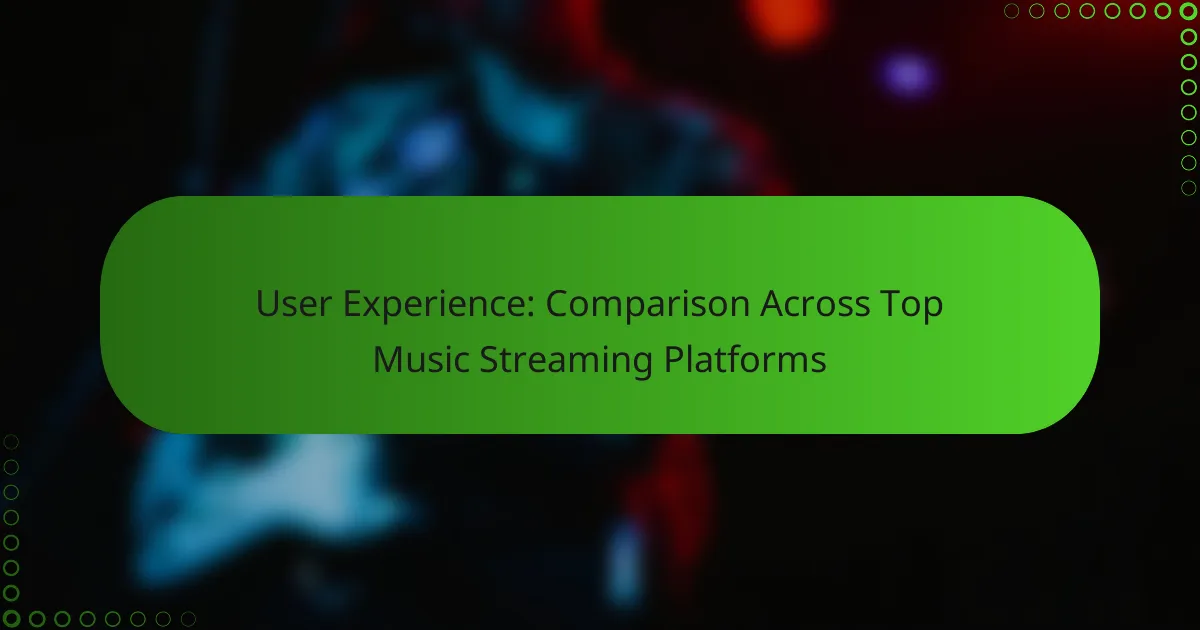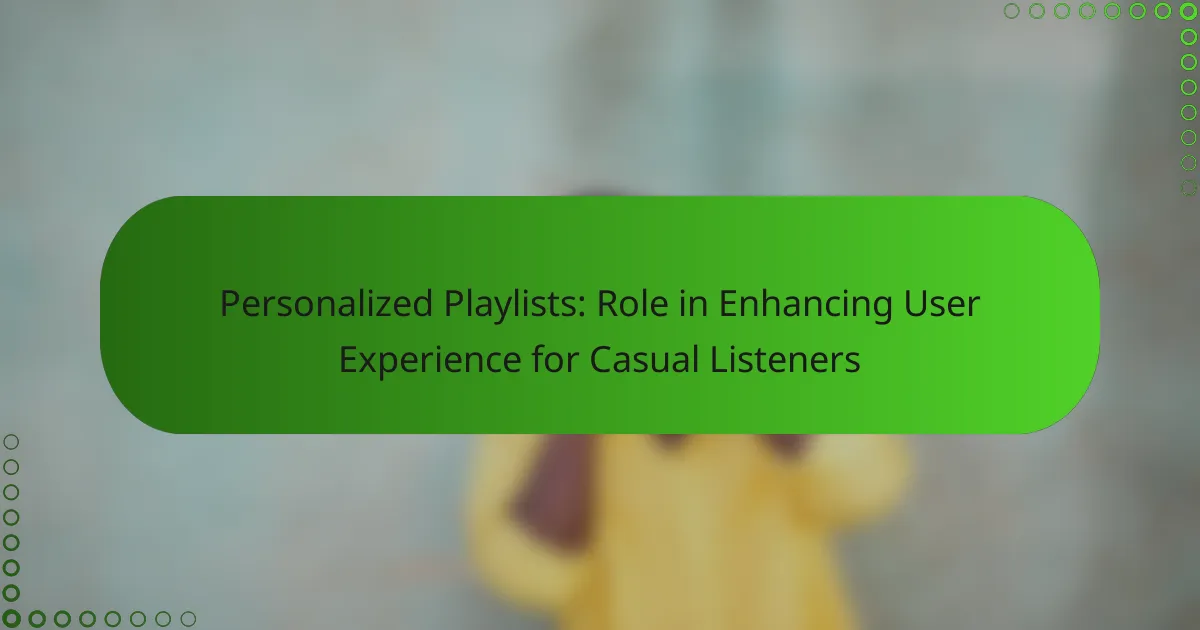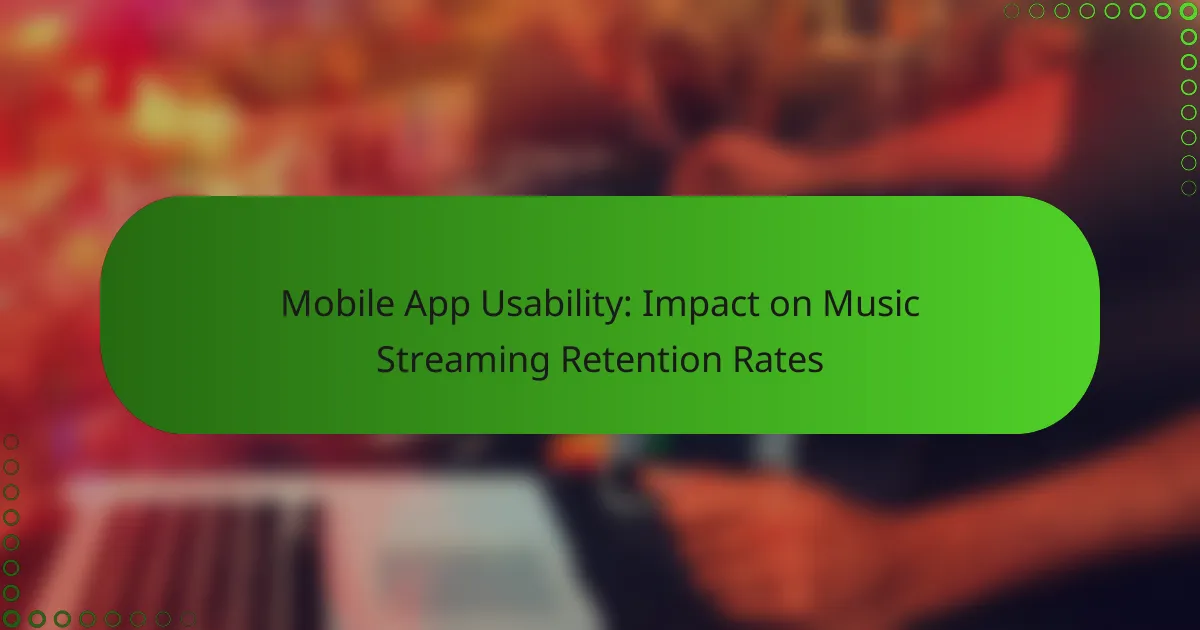In the competitive landscape of music streaming, user experience plays a crucial role in attracting and retaining listeners. Each platform, from Spotify to Tidal, offers distinct features and interfaces that cater to varying user preferences, making it essential to understand these differences. Factors such as navigation ease, aesthetic design, and personalized content significantly influence how users interact with their chosen service.

Which music streaming platforms offer the best user experience?
The best user experience in music streaming platforms often hinges on interface design, ease of navigation, and personalized features. Platforms like Spotify, Apple Music, Amazon Music, YouTube Music, and Tidal each offer unique strengths that cater to different user preferences.
Spotify user experience
Spotify is known for its intuitive interface and robust music discovery features. Users can easily create playlists, follow friends, and receive personalized recommendations based on listening habits.
The platform’s algorithm excels at curating playlists like “Discover Weekly,” which introduces users to new music tailored to their tastes. Additionally, Spotify’s social features allow users to share music and see what friends are listening to, enhancing the overall experience.
Apple Music user experience
Apple Music offers a seamless integration with the Apple ecosystem, making it particularly appealing for users with Apple devices. The interface is clean and user-friendly, allowing for easy navigation between playlists, albums, and radio stations.
One standout feature is the “For You” section, which provides curated playlists and album suggestions based on user preferences. However, some users may find the lack of a free tier a drawback compared to competitors like Spotify.
Amazon Music user experience
Amazon Music provides a straightforward user experience, particularly for Amazon Prime members who have access to a vast library without additional cost. The interface is simple, but it may lack some of the advanced features found in other platforms.
Users can create playlists and access curated stations, but the music discovery tools are not as sophisticated as Spotify’s. However, the integration with Alexa devices enhances usability for those in the Amazon ecosystem.
YouTube Music user experience
YouTube Music leverages its extensive video library to provide a unique listening experience. Users can switch between audio and video seamlessly, which is ideal for those who enjoy music videos or live performances.
The platform’s recommendation engine is effective, often suggesting songs based on viewing history. However, some users may find the interface less polished compared to other streaming services, which can affect overall satisfaction.
Tidal user experience
Tidal is distinguished by its focus on high-fidelity audio quality, appealing to audiophiles who prioritize sound over other features. The user interface is sleek and modern, making it easy to navigate through its extensive library.
While Tidal offers exclusive content and artist interviews, its music discovery features may not be as advanced as those of Spotify or Apple Music. Additionally, the subscription cost is higher, which could be a consideration for budget-conscious users.

How do user interfaces compare across platforms?
User interfaces across music streaming platforms vary significantly in design, usability, and features. Key factors to consider include navigation ease, aesthetic appeal, and the availability of personalized content.
Spotify interface design
Spotify’s interface is known for its clean, minimalist design that prioritizes user experience. The main navigation is straightforward, featuring tabs for Home, Search, and Your Library, making it easy for users to find music quickly.
One standout feature is the personalized playlists, such as Discover Weekly and Daily Mix, which adapt to users’ listening habits. This focus on personalization enhances user engagement and satisfaction.
Apple Music interface design
Apple Music offers a visually rich interface that integrates seamlessly with other Apple services. The layout emphasizes curated content, with sections for For You, Browse, and Radio, allowing users to explore new music easily.
A notable aspect of Apple Music is its integration with iTunes, which allows users to access their existing music libraries alongside streaming content. However, some users may find the interface slightly overwhelming due to the abundance of features.
Amazon Music interface design
Amazon Music features a straightforward interface that aligns with Amazon’s overall design philosophy. The navigation includes tabs for Home, Music Library, and Browse, making it easy to access various music categories.
One unique element is the integration with Alexa, enabling voice commands for music playback. While the interface is functional, it may lack the visual appeal of competitors, which could affect user experience for those who prioritize aesthetics.

What features enhance user experience in music streaming?
Key features that enhance user experience in music streaming include personalized playlists, offline listening capabilities, and social sharing features. These elements cater to user preferences, allowing for a more tailored and engaging listening experience.
Personalized playlists
Personalized playlists are curated collections of songs based on user listening habits and preferences. Many platforms utilize algorithms to analyze your music choices, creating playlists that reflect your taste, such as “Discover Weekly” on Spotify or “For You” on Apple Music.
These playlists can introduce users to new artists and genres, enhancing music discovery. However, it’s essential to regularly engage with the platform to ensure the recommendations remain relevant and fresh.
Offline listening capabilities
Offline listening allows users to download songs and playlists for access without an internet connection. This feature is particularly useful for users who travel frequently or have limited data plans, as it enables uninterrupted listening during commutes or in areas with poor connectivity.
Most streaming services offer this feature, but it typically requires a premium subscription. Users should be aware of storage limitations on their devices and manage downloads accordingly to maximize their offline experience.
Social sharing features
Social sharing features enable users to share their favorite tracks, playlists, and listening activities with friends and followers. This can enhance the music experience by fostering community and allowing users to discover music through social connections.
Platforms like Spotify and Apple Music offer options to share directly on social media or through messaging apps. However, users should consider their privacy settings and be mindful of what they share to maintain control over their listening habits.

What are the pricing models for top music streaming services?
The pricing models for top music streaming services generally include subscription tiers, family plans, and sometimes free ad-supported options. Users should consider their listening habits and budget when choosing a plan, as prices can vary significantly across platforms.
Spotify pricing plans
Spotify offers several pricing plans, including a free ad-supported version, a Premium plan at around $10 per month, and a Family plan for about $15 per month. Students can access a discounted Premium plan for approximately $5 monthly. The Premium plan provides ad-free listening, offline downloads, and higher audio quality.
Spotify also features a Duo plan, which is designed for two people living at the same address, typically costing around $13 per month. This flexibility allows users to choose a plan that best fits their needs.
Apple Music pricing plans
Apple Music has a straightforward pricing structure with a standard individual plan priced at approximately $10 per month. A Family plan, which covers up to six family members, is available for about $15 monthly. Students can benefit from a discounted rate of around $5 per month.
Apple Music does not offer a free tier, but it provides a free trial period for new users. The service includes features like offline listening, curated playlists, and integration with other Apple services.
Amazon Music pricing plans
Amazon Music offers several options, including a free tier for Amazon Prime members, which provides access to a limited library. The standard Amazon Music Unlimited plan is priced at about $10 per month, while Prime members can subscribe for around $8 monthly.
Additionally, Amazon Music offers a Family plan for approximately $15 per month, allowing multiple users to enjoy the service. Users should consider their existing Amazon subscriptions to maximize value.

How do user experiences differ in major cities?
User experiences on music streaming platforms can vary significantly across major cities due to factors like internet speed, device preferences, and local music trends. These differences can influence how users interact with features, content availability, and overall satisfaction with the service.
Internet Connectivity and Speed
In cities with robust internet infrastructure, users often enjoy seamless streaming experiences with minimal buffering. For instance, urban areas in countries like Germany or the United States typically have higher average broadband speeds compared to rural regions, allowing for higher quality audio streaming and quicker loading times.
Conversely, in cities where internet connectivity is less reliable, users may encounter interruptions or lower quality audio. This can lead to frustration and a diminished overall experience, making it essential for users to consider their local internet conditions when choosing a streaming service.
Device Preferences
User device preferences can greatly influence the music streaming experience. In tech-savvy cities like San Francisco or Seoul, users may favor high-end smartphones and smart speakers, which can enhance audio quality and provide access to advanced features like voice control.
In contrast, users in areas with less access to premium devices might rely on basic smartphones or computers, which can limit their experience. Streaming services that optimize for a range of devices can better cater to diverse user bases across different cities.
Local Music Trends and Content Availability
Local music trends significantly impact user experiences on streaming platforms. For example, cities with vibrant local music scenes, such as Nashville or London, may offer unique playlists and exclusive content that cater to regional tastes.
Users in these cities often appreciate the availability of local artists and genres, which can enhance their engagement with the platform. On the other hand, users in areas with less diverse music offerings may find their experience less satisfying if the platform does not adequately reflect their local culture.









